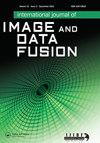基于混合优化策略和contourlet映射的视频显著目标检测
IF 1.8
Q3 REMOTE SENSING
International Journal of Image and Data Fusion
Pub Date : 2020-04-02
DOI:10.1080/19479832.2019.1683625
引用次数: 1
摘要
摘要显著目标检测的进步吸引了许多研究人员,并在计算机视觉应用中具有重要意义。然而,使用静止图像进行有效的显著对象检测是一个主要挑战。本文提出了一种显著目标检测技术,该算法是将灰狼优化器(GWO)和蜘蛛猴优化器(SMO)相结合设计的。该技术经历了三个步骤,包括关键帧提取、显著性映射、轮廓映射,然后使用最优系数融合所获得的输出。最初,提取的帧同时进行显著性映射和轮廓映射,以确定每个像素的质量。然后,使用任意系数对从显著性映射和轮廓映射获得的输出进行融合,以获得用于检测显著对象的最终结果。这里,所提出的S-GWO用于选择用于检测显著对象的最优系数。基于性能指标对所提出的S-GWO进行的实验评估表明,所提出的S-GWO获得了最大的准确性、敏感性和特异性,分别为0.914、0.861和0.929。本文章由计算机程序翻译,如有差异,请以英文原文为准。
Video-based salient object detection using hybrid optimisation strategy and contourlet mapping
ABSTRACT The advancements in salient object detection have attracted many researchers and are significant in several computer vision applications. However, efficient salient object detection using still images is a major challenge. This paper proposes salient object detection technique using the proposed Spider-Gray Wolf Optimiser (S-GWO) algorithm that is designed by combining Gray Wolf Optimiser (GWO) and Spider Monkey Optimisation (SMO). The technique undergoes three steps, which involves keyframe extraction, saliency mapping, contourlet mapping, and then, fusion of obtained outputs using optimal coefficients. Initially, the extracted frames are subjected to saliency mapping and contourlet mapping simultaneously in order to determine the quality of each pixel. Then, the outputs obtained from the saliency mapping and contourlet mapping is fused using the arbitrary coefficients for obtaining the final result that is employed for detecting the salient objects. Here, the proposed S-GWO is employed for selecting the optimal coefficients for detecting the salient objects. The experimental evaluation of the proposed S-GWO based on the performance metrics reveals that the proposed S-GWO attained a maximal accuracy, sensitivity and specificity with 0.914, 0.861 and 0.929, respectively.
求助全文
通过发布文献求助,成功后即可免费获取论文全文。
去求助
来源期刊

International Journal of Image and Data Fusion
REMOTE SENSING-
CiteScore
5.00
自引率
0.00%
发文量
10
期刊介绍:
International Journal of Image and Data Fusion provides a single source of information for all aspects of image and data fusion methodologies, developments, techniques and applications. Image and data fusion techniques are important for combining the many sources of satellite, airborne and ground based imaging systems, and integrating these with other related data sets for enhanced information extraction and decision making. Image and data fusion aims at the integration of multi-sensor, multi-temporal, multi-resolution and multi-platform image data, together with geospatial data, GIS, in-situ, and other statistical data sets for improved information extraction, as well as to increase the reliability of the information. This leads to more accurate information that provides for robust operational performance, i.e. increased confidence, reduced ambiguity and improved classification enabling evidence based management. The journal welcomes original research papers, review papers, shorter letters, technical articles, book reviews and conference reports in all areas of image and data fusion including, but not limited to, the following aspects and topics: • Automatic registration/geometric aspects of fusing images with different spatial, spectral, temporal resolutions; phase information; or acquired in different modes • Pixel, feature and decision level fusion algorithms and methodologies • Data Assimilation: fusing data with models • Multi-source classification and information extraction • Integration of satellite, airborne and terrestrial sensor systems • Fusing temporal data sets for change detection studies (e.g. for Land Cover/Land Use Change studies) • Image and data mining from multi-platform, multi-source, multi-scale, multi-temporal data sets (e.g. geometric information, topological information, statistical information, etc.).
 求助内容:
求助内容: 应助结果提醒方式:
应助结果提醒方式:


